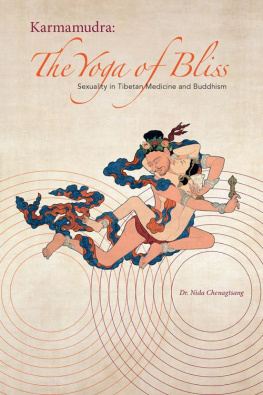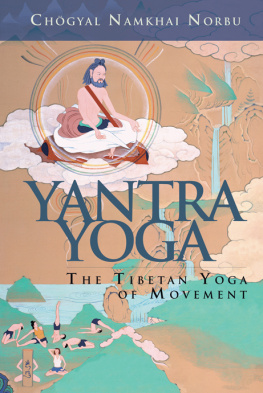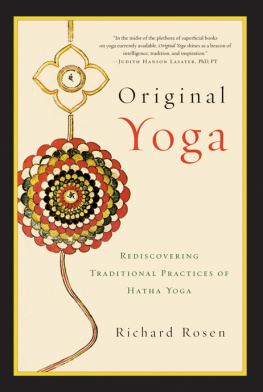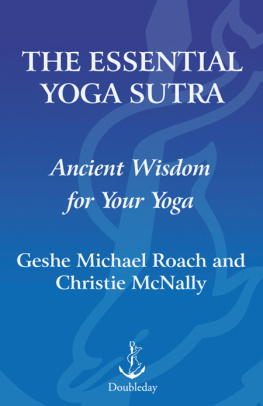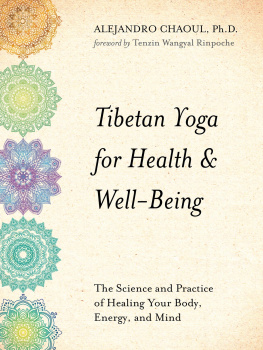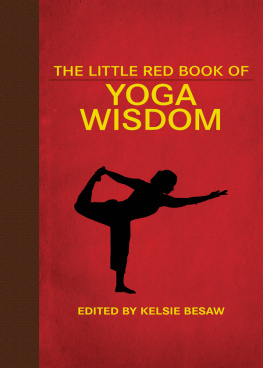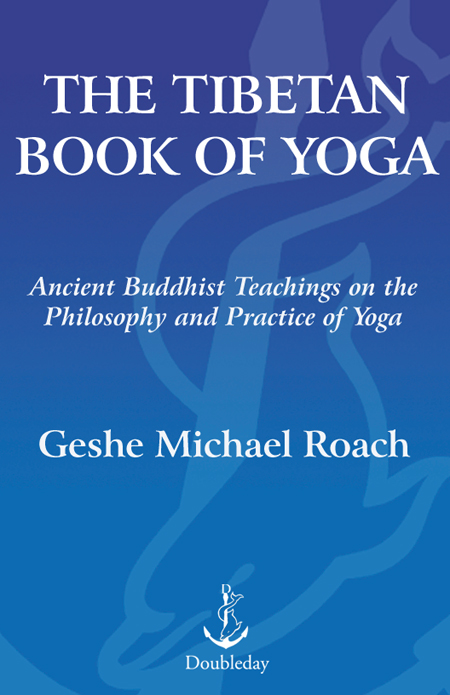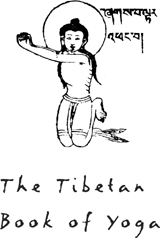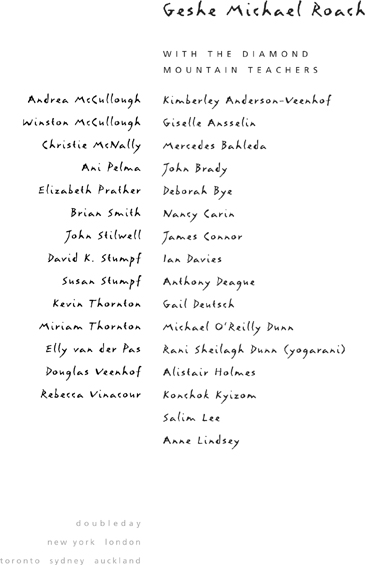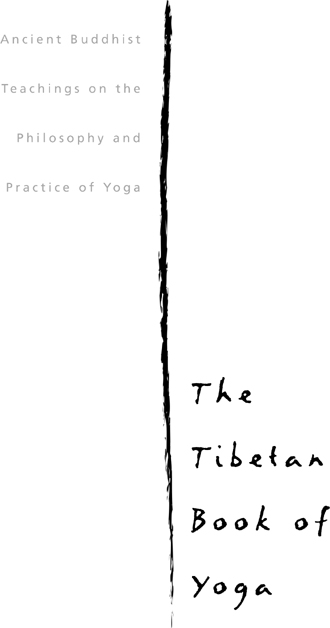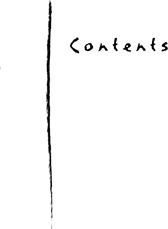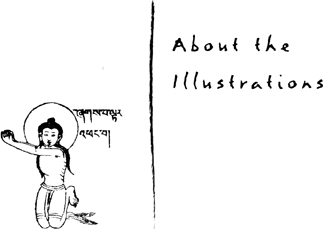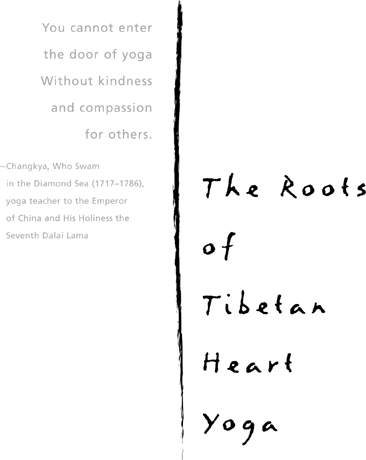Throughout this book you will find a number of traditional illustrations of yoga exercises and ancient masters of the yoga tradition of the Dalai Lamas. Drawings like the one above come from an extremely rare woodblock print that was probably carved in Mongolia and is now held at the Oriental Library of the Russian Academy of Sciences, St. Petersburg.
The carvings of important teachers of the tradition, with Tibetan captions below them, were completed at the Potala Palace of the Dalai Lamas before the fall of Tibet. The one illustration of the channels of the inner body is adapted from a series of yoga exercises in wall paintings discovered at the Lukhang meditation chambers of His Holiness the Sixth Dalai Lama (16831706). And, finally, the more boisterous drawings of yoga poses, without captions, come from the ancient Himalayan kingdom of Sikkim; they accompany a collection of yoga texts written in the 1700s.
Tibetan Heart Yoga in Photographs
The photographs in this book were prepared during a three-year deep retreat, undertaken by members of the author group in the Arizona desert. They show the major steps as you go through the half-hour practice. Be sure to also read the description of each exercise, for more hints and details.
The ancient art of yoga came to Tibet from its birthplace in India over a thousand years ago. It quickly became very popular, and wonderful systems for its practice sprang up like mushrooms all over the country. The yoga practice you will learn here, which is called Tibetan Heart Yoga, belongs to the Gelukpa tradition of the Dalai Lamas of Tibet.
Tibetan Heart Yoga works on your heart in two ways: It makes your physical heart and body healthy and strong, and it opens your heart to love others. And of course really the first always comes from the second.
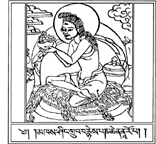
Master Naropa
The instructions for the physical exercises and inner practice of Heart Yoga entered Tibet in two different lineages. The exercisesor what we in the modern world think of as yogawere first taught to Tibetans by the Indian master Naropa (10161110). They form part of an ancient tradition known as the Six Practices, and the Tibetans nicknamed them the Machine of the Body.
The instructions for opening our hearts to others are called tong-len, which means Giving and Taking. This practice involves special ways of breathing and thinking of others, throughout the day, and especially as you do your yoga exercises. The lineage for Giving and Taking goes back over two thousand years to the Buddha himself. It was passed on quietly from teacher to student without being written down and was brought to Tibet by the great Indian sage Atisha (9821052). The practice was first put into book form by a Tibetan, Geshe Chekawa, about a hundred years later, and our presentation here is from his work.
Both the physical exercises and the special breathing techniques merged together by the time of Jey Tsong Khapa (13571419), who describes the yoga poses you find here in a secret text called The Book of Three Beliefs. The three beliefs, by the way, are belief in the beauty of the way; belief in the one who teaches it to you; and belief in yourself, that you will succeed in your practice.
Jey Tsong Khapa was the teacher of His Holiness the First Dalai Lama (13911474), and from here Tibetan Heart Yoga continues up to His Holiness the current Dalai Lama, whose cheerful wisdom and compassion certainly embody its goals. Those of us who have written this book received the instructions on Heart Yoga over many years from great Tibetan lamas, especially Khen Rinpoche Geshe Lobsang Tharchin and Sermey Jetsun Geshe Thupten Rinchen. They in turn received them chiefly from Kyabje Trijang Rinpoche, the teacher of His Holiness the Dalai Lama. Thus it is an authentic yoga you will learn here, and we hope that the blessings of this long line of masters will touch you, even if we ourselves as teachers are but mere babes by comparison.

Geshe Chekawa
The daily half-hour program for Tibetan Heart Yoga presented in this book is both similar to and very different from other kinds of yoga being taught today. On one hand we have selected exercises that you are probably already familiar with if you have ever tried yoga; you will feel at home here whether you are just starting out or whether you are already attending classes in the Ashtanga, Iyengar, Shivananda, Jivamukti, Bikram, or another common yoga tradition. We ourselves enjoy and practice these well-known programs too; this book was in fact written during a deep three-year retreat in the Arizona desert, and throughout this time we received training in these five systems by kind and dedicated teachers who traveled far to come and instruct us, often at their own expense.
Each of the standard yoga poses you find here is accompanied by an additional pose that will be new for you; these are from the book by the teacher of the First Dalai Lama. These exercises deepen and strengthen the effect of their sister poses. But the most important difference between this yoga tradition and the others is in how you breathe and what you think about as you do your exercises. The Heart Yoga of Tibet works from both the inside and the outside, to bring you lasting strength and calmness. So next let's take a look at how this happens.
Most of us are interested in yoga because we hope that it will give us more energy, better health, a trim and more flexible body, and of course peace of mind. Most of us too are more likely to really put our heart into a daily program like this if, at the very beginning, someone can give us a clear idea of how it works. To understand how helpful Heart Yoga can be, you need to understand what we call the Five Levels.
Think of your body like an onion. On the outside are all the parts we can see: arms, legs, tummy, and such. When we do yoga, this outer layer is what we think about the most. Where am I supposed to put my foot? Where does my arm go? Am I finally looking better?


